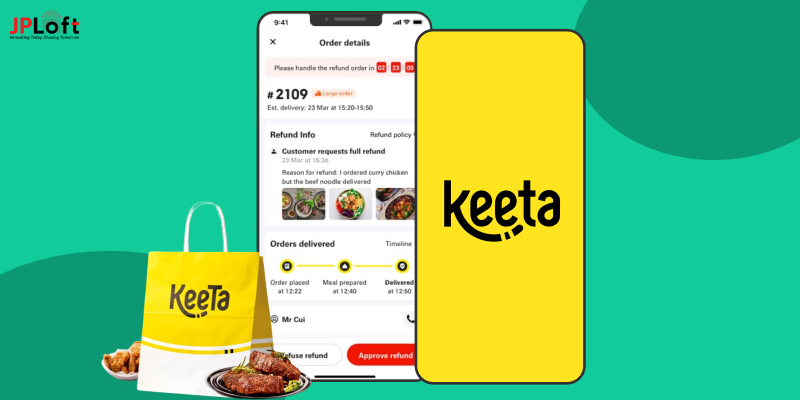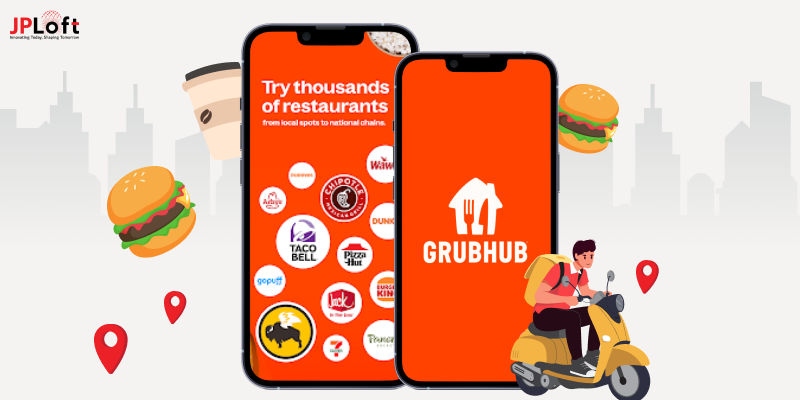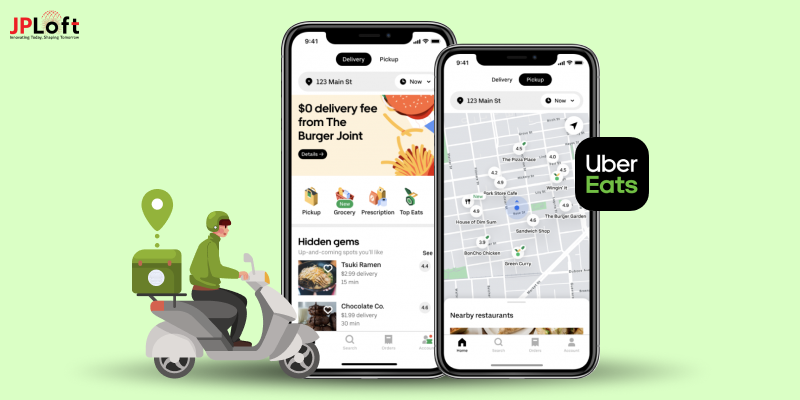Food delivery apps, particularly Uber Eats, GrubHub, and Zomato - which offer intuitive navigation and user-centric features and comfort - have successfully revolutionized the on-demand food delivery market.
Over the past several years, on-demand applications have seen exponential revenue and user growth. Particularly in 2020, when people could no longer freely leave their homes to dine out or shop for groceries without incurring penalties, online food industry revenue reached more than $302,826 million and is projected to expand even further in 2022.
One key moment stands out as we track the rapid rise of online food delivery services: the pandemic. People's perception has certainly changed, and usage of such apps has increased post-pandemic.
Imagine coming home after an exhausting day at work, and all you can think about is devouring a double cheese pizza slice - but are too tired to cook one yourself? In that instance, many will order food through Uber Eats or another on-demand food delivery app like the Hungry House App.
On-demand mobile services enable us to use mobile apps for everything from hailing a taxi, receiving medical advice, or ordering medical marijuana delivery. They're immensely popular with users as they save both time and effort - an on-demand business model is tailored specifically for cargo transport and dog walking services.On-demand apps have quickly become extremely popular due to their wide target audience and market
Factors Affecting Food Delivery App Development Cost
The costs associated with app development largely depend on its features; however, business analysts and developers take careful account of various factors which determine these features as well as the associated cost estimates - this also applies to developing food delivery apps; here are the seven most critical ones:
Scope, Category, and Features of the Food Delivery Application
Food delivery app development company projects involve several key considerations that profoundly affect their cost, with scope, category, and features having major ramifications on overall costs. With food delivery applications already established and being utilized by restaurants worldwide as a service offering, food delivery apps are already clear-cut and secured as its niche market.
Your selection of platforms affects costs as well. Native Android development tends to be cheaper, while iOS app development tends to cost slightly more; cross-platform and flutter development options provide more cost-effective and attainable solutions for businesses and aspiring entrepreneurs.
Development Time
A general rule in the app development industry is: the more features, the longer is required for designing, developing, testing, and deployment. Each app feature requires specific technical specifications and time investment from designers and developers in its creation, design testing, and deployment.
As previously discussed, food delivery apps usually take between 550 - 800 development hours in their development process. To get a quick rough estimate of this number, multiply your hourly developer rate by your estimated development hours when considering which technologies or tools will best meet these demands
Development Tools and Technologies
An app for food delivery needs an impressive backend, admin panel, and analytics dashboard equipped with cutting-edge tools.
Suppose the Bitcoin payment option is one of your unique selling propositions for an app. In that case, a conversion platform might be required - and as such, you may incur costs for deployment and integration services.
Simply stated, developing an app with cutting-edge technologies requires spending more on development costs. Conversely, being an early adopter can give your food delivery app an edge against its current and potential future competitors.
Development Process
Some top on-demand app development companies now provide full-cycle app development and individual services like prototyping, design, programming, testing, maintenance, and launching.
Logically speaking, what you pay for is determined by your required services. Our business opportunists and analysts recommend that new appreneurs invest in a full-cycle development process rather than in standalone services, as this will keep the budget under control while streamlining business process management.
Complexity of Design
Once you have reviewed various stages and their costs, it is also important to remember that complexity of any level can affect cost; for instance, if you opt for minimalist designs with low-key branding, this can have an extremely positive effect on budgeting.
App Security
Food delivery app development requires high-end app security due to the personal and financial data they handle to pay food bills, both of which should remain private and protected at all times. To provide users with an optimal user experience, your app should remain secure to protect these details.
On-demand app developers use various strategies to ensure app security. First, they employ end-to-end encryption so messages and data shared within an app stay within it; secondly, they ensure backend development uses error-free tools and virus-free development toolkits.
All data security measures come at a cost. While you may want to limit your budget, compromising user data security or giving hackers access to your app's back end should never be an option
The Cost of Developing a Food Delivery App
Estimating the costs involved in creating a food delivery app without knowing your business requirements would be like asking an unanswerable question of experts.
Estimating mobile app development costs is much like purchasing a new car: costs vary based on factors like model, features, and machinery; similarly, costs associated with creating food delivery apps will differ based on different variables.
Major app design decisions depend on its implementation. Costs will differ based on factors like native versus hybrid app development and service offering - for instance, the cost to hire on-demand app developers to develop a typical food delivery app such as UberEats would be around $20,000 with monthly hosting and maintenance investments of $500-$1,000 required.
Costs associated with food delivery apps typically fall within $10,000-12,000 for basic apps; larger enterprises with greater resources and funding may incur more than $25,000.
Cost estimates should also include expenses related to advertising the app, such as Facebook ads ($300-$500 daily),TV spots (7,500+ per 30 seconds),and print ads (5k+ per full page),which could all add up quickly.
Food delivery service startups typically range between $5,000 - $15,000. When starting up, an MVP solution should be used and later scaled with advanced features
Want to Develop On-Demand Food Delivery App ?
Select Your Food Delivery App Development Company From Top Companies!
List Of CompaniesHow Can Monetize and Profit From Food Delivery Apps?
You can employ various monetizing models when developing a food delivery app. Still, the most successful food delivery apps like Uber Eats, DoorDash, or Postmates use commission fee models instead of subscription charges as their revenue model. Below is what each popular food delivery service charges per order:
As well as commission fees, here are other strategies you can employ to monetize a food delivery app:
Paid Subscriptions: Some apps charge users monthly or yearly subscription fees in exchange for exclusive content and no ads - with potential benefits including accessing exclusive features or having no advertisements displayed in-app.
Premium Features: Some apps charge users one-time fees to gain access to features such as expedited deliveries or special menus.
Sell Products: Food apps also frequently sell their own branded merchandise and that from other companies.
Marketing Contracts: Some companies pay app developers money to have their logo prominently on the home screen.
Market Place: Apps that enable people to order food directly from restaurants instead of having it delivered themselves may receive payment from both parties involved.
Sponsorships: Many food app companies host events sponsored by local restaurants that receive advertising exposure in return.
Content Subscriptions: Some food apps offer free recipes in exchange for accessing videos and articles, giving away advertising exposure as a result.
Freemium Model: Some apps offer free and optional features that only work when purchased as part of their full version. They are often advertised as available to all levels (the "freemium model").
Conclusion
We come to our final thoughts based on our knowledge about developing on-demand food delivery apps and their market shares. Food delivery app usage is projected to hit 2,638 million by 2025, with established services like Uber Eats, Grubhub, DoorDash, or Zomato dominating most markets. However, there's still space for startups like yours to compete and attract users - internationalization even allows you to bring homegrown apps abroad!
Uber Eats and Doordash may have captured most of the online food delivery industry. Yet, opportunities exist for startups or established companies looking to break into it by targeting specific audiences with their apps.
As with any business model, when considering this model, it's essential to remember all stakeholders (users, couriers, and restaurants) are interdependent. You must strike a balance in providing value to each of them. It can be seen as a chicken and egg situation: users cannot exist without couriers (and vice versa with restaurants). Therefore professional apps with clear business logic become essential tools in helping manage this equation successfully.
The online food delivery market is vast, reaching 110.8 million users by 2027. This provides an exciting opportunity for those in the field hoping to make it big with online food deliveries.












Share this blog